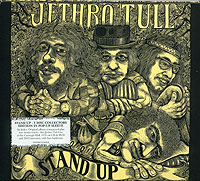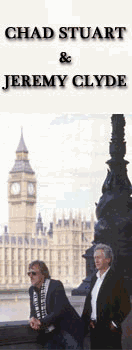 I
can remember interviewing Justin Hayward in early 2006, just after
my dad died and me and old Justin started reflecting back on things
like Mike Pinder and the ‘60s and when I asked Justin what his
favorite music is, he said something to the effect that it was the
music he grew up with. Somehow that concept of things pretty much
sums up my feelings both about the early Moody Blues and early Jethro
Tull albums and high on the list of early rock classics from the
‘60s remains Tull's 1969 Stand Up album. I can
even remember back that crisp autumn day I bought the Lp, I was walking
home with my proud copies of Stand Up and Songs For A Tailor
by Jack Bruce. It would be one of those nights—forget about
“homework” if you catch my drift. Back when I interviewed
Ian Anderson in 2008—part of which was a cover story for
the now deceased 20th century guitar mag—me and Ian got to talking
about mono versus stereo. Not contrary to the excellent 2008 mono
CD reissue of This Was Jethro Tull, in my opinion, by 1969,
the major players in U.K. rock (Anderson included) had worked out
the kinks in the (now) currently raging mono raining supreme over
stereo in the '60s debate—with to my mind mono ruling just a
year before in 1968. To bring out that point on the 3 disc 2010 remaster
of Stand Up, give a listen to both stereo version of and a
rarely heard mono version of (what in retrospect became) the single
from Stand Up, Anderson's orchestral classic “Living In
The Past”, recorded while Tull was on tour in 1969 in New Jersey
and San Francisco. Looking back on 1968 becoming 1969, “Living
In The Past” was clearly one of the first rock songs to really
maximize the full stereo effect. With Stand Up, Tull founder
Ian Anderson became, historically, one of the key English songwriting
geniuses who, in 1969 was able to adapt to and as such, maximize that
newly emerging world of stereo in the rock world. So to sum up students,
mono was the ‘60s and (by 1969), stereo was the ‘70s! Pure
and simple. The excellent business skills of Chrysalis Records founder
Terry Ellis gave Anderson an incredible amount of artistic
freedom on what many say is the first real Tull album—the
band that started post-Bloodwyn Pig guitarist Mick Abrahams. Anyway,
on the evergreen Stand Up, Anderson’s band of newcomers,
including soon to be guitar god, Martin Barre, and the groundbreaking
rock rhythm section of Glen Cornick and Clive Bunker is
the quartet that, in my opinion, truly defined who Tull was and became
at their best. Okay, throw in John Evan on grand piano and
I’ll be happy! Anyway this 2010 triple Tull threat features the
entire Stand Up album, newly remastered, along with eleven
bonus cuts on CD 1 while disc 2 and 3 features Tull’s historic,
never fully released 1970 Live At Carnegie Hall show—which
is here in its entirety on disc 2 (on CD) and again in DVD audio on
disc 3, which, also features a quite in depth, 2010 DVD video interview
of Ian Anderson. Heck, EMI did a great remake / remodel and they even
reproduced that little Tull art design pop up "Stand Up"
image of the band, thirty years before the internet made the term
pop-up famous! www.JethroTull.com
I
can remember interviewing Justin Hayward in early 2006, just after
my dad died and me and old Justin started reflecting back on things
like Mike Pinder and the ‘60s and when I asked Justin what his
favorite music is, he said something to the effect that it was the
music he grew up with. Somehow that concept of things pretty much
sums up my feelings both about the early Moody Blues and early Jethro
Tull albums and high on the list of early rock classics from the
‘60s remains Tull's 1969 Stand Up album. I can
even remember back that crisp autumn day I bought the Lp, I was walking
home with my proud copies of Stand Up and Songs For A Tailor
by Jack Bruce. It would be one of those nights—forget about
“homework” if you catch my drift. Back when I interviewed
Ian Anderson in 2008—part of which was a cover story for
the now deceased 20th century guitar mag—me and Ian got to talking
about mono versus stereo. Not contrary to the excellent 2008 mono
CD reissue of This Was Jethro Tull, in my opinion, by 1969,
the major players in U.K. rock (Anderson included) had worked out
the kinks in the (now) currently raging mono raining supreme over
stereo in the '60s debate—with to my mind mono ruling just a
year before in 1968. To bring out that point on the 3 disc 2010 remaster
of Stand Up, give a listen to both stereo version of and a
rarely heard mono version of (what in retrospect became) the single
from Stand Up, Anderson's orchestral classic “Living In
The Past”, recorded while Tull was on tour in 1969 in New Jersey
and San Francisco. Looking back on 1968 becoming 1969, “Living
In The Past” was clearly one of the first rock songs to really
maximize the full stereo effect. With Stand Up, Tull founder
Ian Anderson became, historically, one of the key English songwriting
geniuses who, in 1969 was able to adapt to and as such, maximize that
newly emerging world of stereo in the rock world. So to sum up students,
mono was the ‘60s and (by 1969), stereo was the ‘70s! Pure
and simple. The excellent business skills of Chrysalis Records founder
Terry Ellis gave Anderson an incredible amount of artistic
freedom on what many say is the first real Tull album—the
band that started post-Bloodwyn Pig guitarist Mick Abrahams. Anyway,
on the evergreen Stand Up, Anderson’s band of newcomers,
including soon to be guitar god, Martin Barre, and the groundbreaking
rock rhythm section of Glen Cornick and Clive Bunker is
the quartet that, in my opinion, truly defined who Tull was and became
at their best. Okay, throw in John Evan on grand piano and
I’ll be happy! Anyway this 2010 triple Tull threat features the
entire Stand Up album, newly remastered, along with eleven
bonus cuts on CD 1 while disc 2 and 3 features Tull’s historic,
never fully released 1970 Live At Carnegie Hall show—which
is here in its entirety on disc 2 (on CD) and again in DVD audio on
disc 3, which, also features a quite in depth, 2010 DVD video interview
of Ian Anderson. Heck, EMI did a great remake / remodel and they even
reproduced that little Tull art design pop up "Stand Up"
image of the band, thirty years before the internet made the term
pop-up famous! www.JethroTull.com





